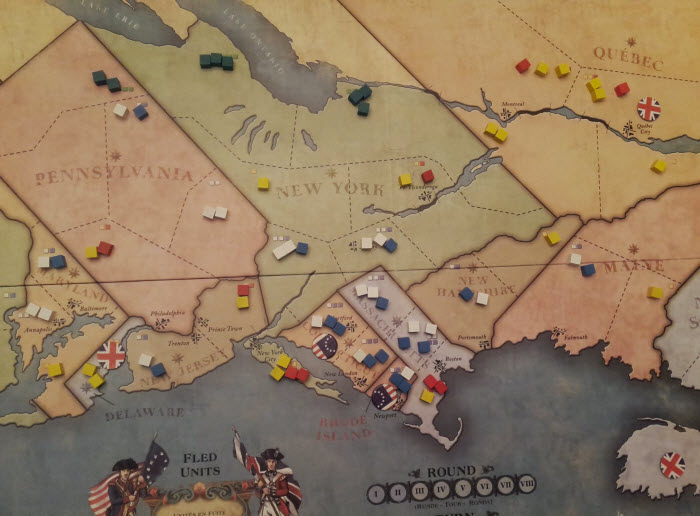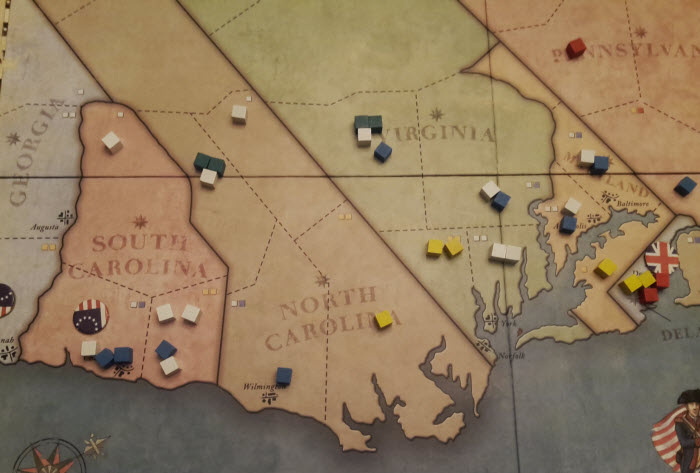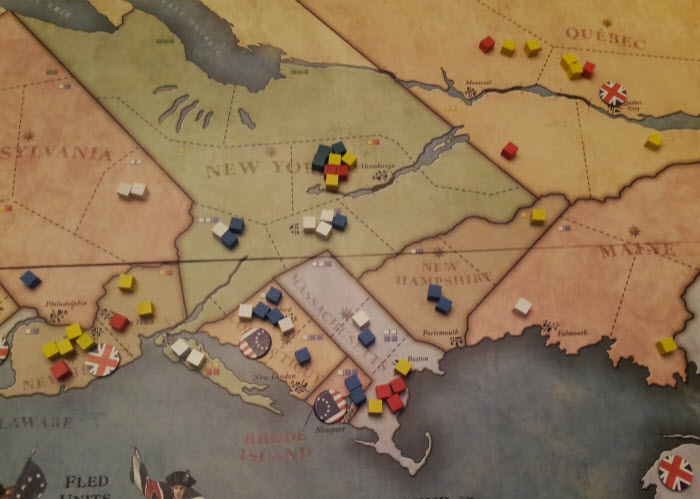“Stand your ground. Don’t fire unless fired upon. But if they want a war, let it begin here.” – Captain John Parker. Lexington, Massachusetts. April 19, 1775.
The Premise
The American Colonies, tired of unfair treatment under English rule, have raised up their voices and their arms in open rebellion. Players command each side’s military forces in this historical event, be it the British Regulars and their allies, or the fledgling Continental Army and their fellow patriots. The American Revolution has begun, and only one said can emerge victorious.
The Rules
1775 is a team-based strategy game about the American Revolution. Setup requires table space and a few minutes to place all of the starting units. Each side is comprised of two major factions: the standing army and the militias. All four factions are used, regardless of the number of players.
To start, each faction receives their supply of forces, Battle Dice, and a small deck of cards to which players draw three. Unlike similar games, the objective in 1775 is not to eliminate the opponent, but to control the most colonies. To control a colony, each space must either be empty or contain only that side’s units. (Native Americans are neutral until a unit from one side moves into their territory.)
1775 is played out over a series of rounds. Turn order is determined randomly: each round, a faction cube is drawn, and that faction takes their turn. Turns break down into four phases: Reinforcement, Movement, Battle, and Draw. Reinforcement consists of the player taking four new units from their supply and retrieving any of their units that fled in previous battles. Units are then distributed however they wish into cities of colonies their side controls. In Movement, the player then chooses and plays one Movement card from their hand. Movement cards specify the number of armies that can move, as well as the number of spaces each can move. Armies moving may consist of as many units as they wish, and can contain units from their allies, but at least one army unit must be of their faction. If one or more armies move into territory controlled by the opposing faction, it resolves in the Battle phase.
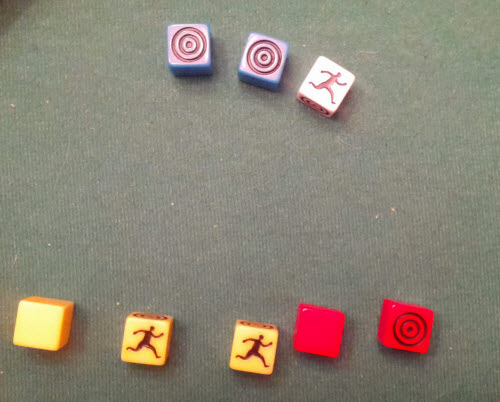
The colonists defended, scoring two Hits and one Flee. After losses, the British attackers rolled one Hit, two Flees, and two Command Decisions.
Battle in 1775 is controlled by a series of dice rolls. Each faction has unique Battle Dice to use in combat. Dice come with three possible outcomes: Hit, Flee, or Command Decision. The number of dice players roll cannot be higher than the number of their units in that space or the number of dice they have.
Flee results cause one unit to be removed to the Fled Units section of the board. Hits result in losing that unit. Command Decisions allows the player to optionally move a unit to an adjacent non-enemy space. At the beginning of each combat, the defending side rolls and resolves their Battle Dice first. Then the attackers roll theirs. This repeats until only one army remains.
Once all battles are resolved, the faction draws back up to three cards and ends their turn. The next faction cube is then drawn from the bag to take its turn. After all factions have played, a new round begins.
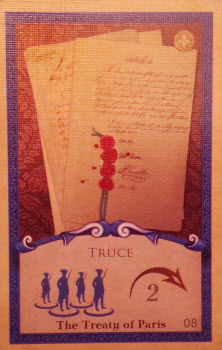
One Treaty down, one to go.
Factions may also play powerful Event cards. The most important of these is the Truce card. Truce cards work as normal Movement cards, but they are not discarded. When both factions of one side play their Truce cards, the game ends after the current round. (There is a minimum of three rounds, however.)
The winning side is the one who controls the most colonies at game end.
However, if both factions end with the same number of colonies, neither side wins, and the colonies are now the loyal subjects of French Canada. Sorry, but those are the rules.
No, really.
Lessons in Warfare
One of the things that makes 1775 (and its predecessor, 1812) stand out is that they’re an unusual hybridization of game. At first glance 1775 bears a lot of hallmarks to your classic wargames: it has a direct military-styled focus and it’s centralized around conflict. The emphasis is less on visual detail and more about the strategies to best your opponent. Rather than simply call it a historically-based Risk, though, 1775 is also still very much a typical modern Ameritrash board game with definite Area Control attributes. There’s a variety of decisions to make, it possesses a solid theme, and luck still plays a large factor in the outcome. Additionally, the inclusion of the unique faction-based Event cards provide the game with more variety than first thought, without getting saddled down in length or complexity issues. The result is a game that has wider appeal then similar games of its kind.
That said, 1775 doesn’t hide the fact that it’s a thematic game about fighting pitched battles and conquering territories; expect your Architects to pass on this one.
Learning Exercises
Generally speaking, games designed around teaching something fall under a very different lens than normal games. Their principal focus is to be fun, yes, but also to educate. And, generally speaking, this often doesn’t go well from a gaming perspective, because either:
- It’s too one-sided. Usually, a poor educational game puts too much focus on the ‘learning’ part, and the ‘game’ part ultimately feel tacked on and underdeveloped. It appears more a learning tool than an actual game, discouraging a wider audience.
- It’s too rigid. Educational games wish to impart valuable material, but many make the mistake of adhering too tightly to that material. A game about the 60’s space race, for example, would not do well if the person playing the USA always won in the end.
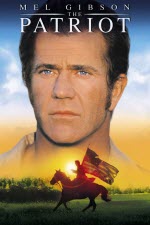
At least 1775 doesn’t just make historical events up…
It sounds almost contradictory, but worthwhile educational games focus on making the game fun and mask the learning. If players enjoy themselves enough in their actions, often the game leaves such a positive experience that many don’t even realize they’re also learning something in the process. 1775 (by the aptly-named Academy Games) is one such example. 1775 is clearly about the American Revolution, and yet it isn’t so dogmatic to the source material as to make the game stale or boring.
More overt learning material can be found at the back of the rule book, but rather than be heavy-handed in-game, it instead subtly includes a number of facets based on real historical anecdotes. The Battle Dice for militia, for example, have a higher Flee rate, illustrating the unreliability of militias at the time. Both sides can recruit Native Americans to their cause – which also actually happened. It’s almost a guarantee that an early battle will occur in Boston. The board is a replica of a colonial-era map. And so on. Without being apparent, 1775 successfully incorporated all of these educational aspects into it.
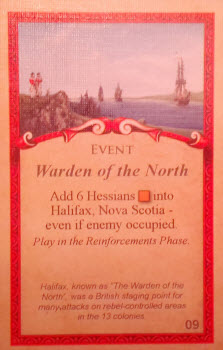
A British Event card, complete with historical footnote.
While we don’t recommend using it to study for your history exam, 1775 nevertheless is a great example of an education-positive game done well, and it should be lauded as such. It has a good amount of theme, though the flavor to it is a bit more nuanced and may not be evident at first.
Whether 1775 entices Immersionists depends on whether they seek to be a character or to be the storyteller. Players are nameless generals in 1775, as are the troops they command. Only Event cards name actual individuals from the American Revolution, leaving little in the way of material for investing in the roleplaying side of things. However, there is a very clear worldbuilding narrative being played out throughout the turns, and when combined with the tightly-woven source material, it makes a strong story presentation. Even if you’re mostly looking at little wooden cubes.
More Common Sense
You don’t have to know a thing about American history to play 1775, but you’ll probably want it to be enjoyable. Indeed, 1775 does a remarkable job at keeping the game accessible to multiple groups of players with its straightforwardness and ease of learning the rules. If you’re playing with more than two people, the team-based approach of collaborating ideas (and forces) is also a nice touch. This combination of light rules and player interaction makes 1775 surprisingly pliable to even interest some Socializers – so long as they’d get to play on a team. They’ll have no interest in a 1v1 session. Even played with a teammate, their interest could still wane if the game begins to drag on too long. The fact that this archetype would consider such a game at all, though, is a testament to the openness 1775 presents.
Moreover, 1775 will also certainly entice Strikers and Tacticians. Strikers will like deploying their forces in a test of strategic skill against their opponent. Although 1775 is about more controlling territory over eliminating the other side, you have a clear long-term goal, and they cherish that. (Indeed, the use of Command Decisions makes fully annihilating armies quite difficult without significant investment.)
Tacticians, on the other hand, will have some pause. As one would expect with anything involving troop deployments, 1775 has a lot of strategy. But the game is also fairly light on tactics. Planning multiple steps ahead can be a difficult task, as turn order is random and unknown until the cube is drawn. Not knowing who is going to go next – themseleves especially – limits their scheming to their turn and some loose hypotheticals around what the other factions may do next. Event and water Movement cards add some light tactical variety into the game, but 1775 is not as deep as some Tacticians may prefer. It is a game that Tacticians will enjoy, but it could be a game some could lose interest after multiple playthroughs. However, the game comes with additional scenarios beyond the base game that adds new variety to gameplay, and that extends its shelf life longer.
That said, while Tacticians have enough other conditions to overcome the more linear approach to victory, the forthright nature of 1775 won’t be something Daredevils will enjoy, and they’re best to skip the game altogether. There’s simply no viable reward in 1775 for making unorthodox military moves for the sake of it, such as spending four rounds rallying the Native Americans of Appalachia to invade Nova Scotia.
The Takeaway
1775 Rebellion combines characteristics of a wargame with thematics of an area control game, and then it interlaces the entire thing with historical references. The actual conflict took several years and changed the course of history in ways that few who lived during the time could imagine. The game, however, can settle the matter in an hour or two. Whether you ultimately bill 1775 as a casual wargame, an educational game about the American Revoltion, or simply a modern alternative to Risk doesn’t detract from what it offers. 1775 allows players to take command of mighty forces, with each player wielding both military troops and a firm conviction of their cause. The game can be a bit spartan to look at, lacking defined pieces or map terrain, and the random turn structure and the luck of dice-based combat largely decides the outcome of many battles. Nonetheless, 1775 Rebellion distills a significant historical event down into a decent game that can equally be played at a kitchen table or in a classroom. In any case, there’s plenty of room for entertaining gameplay here. But don’t blame us if you also learn a thing or two in the process.
1775 Rebellion is a product of Academy Games.
Cardboard Republic Snapshot Scoring (Based on scale of 5):
Artwork: 3
Rules Clarity: 4.5
Replay Value: 3.5
Physical Quality: 3
Overall Score: 3.5

